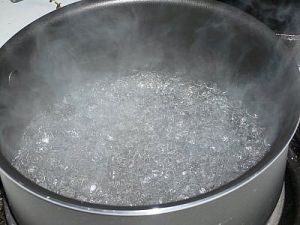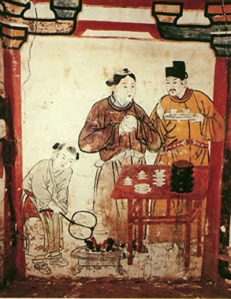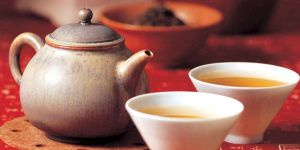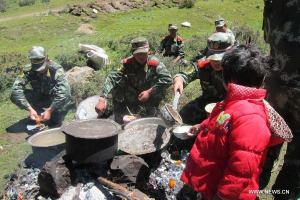 In May 2013, I gave a series of lectures at Tsinghua University and other academic institutions in China. During my travels, I was hosted at a number of banquets. I do not drink alcohol, so it was a little awkward when the time came for giving toasts. I am sensitive to caffeine, so tea was not an option. As is my custom, I asked for water—plain water. I received boiled water from a thermos, and the water was still hot when it was poured into my glass. I thought that this was curious.
In May 2013, I gave a series of lectures at Tsinghua University and other academic institutions in China. During my travels, I was hosted at a number of banquets. I do not drink alcohol, so it was a little awkward when the time came for giving toasts. I am sensitive to caffeine, so tea was not an option. As is my custom, I asked for water—plain water. I received boiled water from a thermos, and the water was still hot when it was poured into my glass. I thought that this was curious.
I asked some of the professors and students I was with about the hot drinking water. They told me that it was the custom in China to only drink boiled tap water. Also, serving water that is hot assures the person receiving it that the water was previously boiled. No one drinks cold water out of the tap. They drink bottled water cold or at room temperature, but tap water is treated differently. Ok, but there must be more to this story.
Introduction
Any current guidebook about China carries an explicit warning: Don’t drink tap water unless it is boiled. I was aware that China’s surface water supplies are polluted, but I was also certain that China was employing at least conventional water treatment including filtration and disinfection for large city water supplies. What happens in the pipes is a different story. A few years ago in Taiwan, I was told that water leaving the treatment plants was safe to drink but during its passage through an aging pipe system, there were numerous opportunities for contamination by leaking sewers. People in Taiwan also boil their tap water.
It is pretty clear that boiling water began in China in ancient times as an individual solution to drinking water that people knew from their observations was not safe. No central water systems served safe drinking water to cities in ancient times. Historical writings about China describe how this individual health protection measure became a cultural institution. Also, drinking boiled water is inextricably linked to the widespread consumption of tea. The history of tea in Chinese culture is part of the history of individuals protecting themselves from disease.
China Boiling: Tea and Water
 Tea drinking in China originated according to several traditions. A legend has Emperor Shennong accidentally discovering tea as a drink in the year 2737 BCE. One account focused on the sanitary idea. “Once upon a time King Shen Nong, known as the father of agriculture and medicine, decreed that for health reasons his subjects must boil water before drinking it.” (Evans 1992) [One should always be careful about stories that begin “once upon a time…”] While a servant was boiling water for the Emperor’s use, leaves from wild tea branches were accidentally blown into the cauldron of boiling water. The Emperor so enjoyed the taste of the flavored beverage that he investigated the domestic cultivation of tea.
Tea drinking in China originated according to several traditions. A legend has Emperor Shennong accidentally discovering tea as a drink in the year 2737 BCE. One account focused on the sanitary idea. “Once upon a time King Shen Nong, known as the father of agriculture and medicine, decreed that for health reasons his subjects must boil water before drinking it.” (Evans 1992) [One should always be careful about stories that begin “once upon a time…”] While a servant was boiling water for the Emperor’s use, leaves from wild tea branches were accidentally blown into the cauldron of boiling water. The Emperor so enjoyed the taste of the flavored beverage that he investigated the domestic cultivation of tea.
There are early references in Chinese literature that recognized the significance of clean drinking water.
“The importance of supplies of pure drinking water was appreciated very early amongst the Chinese. Already in one of the most ancient texts, the I Ching (Book of Changes) which we might date somewhere about the -7th century [7th century BCE], we find the commonplace, ‘Men do not drink water from foul wells.’ The Shih Ming dictionary (+100) [1st century CE] says, punning, ‘A well (ching) means essentially clear and clean (chhing), the clear produce of a spring.’ Regular custom in ancient China demanded the periodic cleaning of wells.” (Needham et al. 1970)
 Tea is mentioned in writings in the third and second centuries BCE. About 800 CE, Lu Yu wrote the first definitive book on tea during the Tang Dynasty (618 to 906 CE). One author credited tea with germ-killing and healthful properties that were advantageous during that period.
Tea is mentioned in writings in the third and second centuries BCE. About 800 CE, Lu Yu wrote the first definitive book on tea during the Tang Dynasty (618 to 906 CE). One author credited tea with germ-killing and healthful properties that were advantageous during that period.
“Its powerful antiseptic properties meant it was safer to drink than previous beverages such as rice or millet beer, even if the water was not properly boiled during preparation. Modern research has found that the phenolics (tannic acid) in tea can kill the bacteria that cause cholera, typhoid, and dysentery [not that anyone knew this in the 7th century]. Tea could be prepared quickly and easily from dried leaves and did not spoil like beer. It was, in effect, an efficient and convenient water-purification technology that dramatically reduced the prevalence of waterborne diseases, reducing infant mortality and increasing longevity.” (Standage 2005)
Care must be taken when viewing old texts describing China. Western authors viewed Chinese practices through their lens of, oftentimes, a staggering fount of ignorance. However, in some cases, observations by western travelers give us insight into daily practices.
“The climate of the northern part [of Hainan Island] is very unhealthful, especially on account of the water; the inhabitants are obliged to boil the quantity of water in the morning, which they design to use all that day.” (Brookes 1741)
This statement written in the middle of the 18th century CE is interesting for a number of reasons. First, the author assumes that the so-called unhealthfulness of the northern part of the island was somehow linked to the water. The revelations of Dr. John Snow and the cause of the cholera episode near the Broad Street pump and its relation to contaminated water was not published for another 115 years. The germ theory of disease was not espoused by Pasteur for 125 years. Second, the author observed that the inhabitants of the northern part improved the unhealthfulness of the water by boiling it. No explanation is given how boiling was know to be the way to improve unhealthful water—an early example of waterborne disease prevention.
Recent histories of China often observe the role that tea and boiled water played in providing a healthful drink.
“…the most influential discovery [by the Chinese] was tea, a beverage that would have profound effects on Chinese art and literature and on its economy….Throughout history, Chinese attributed wondrous benefits to tea drinking, including cures that cannot be proven. However, tea was valuable because it offered the benefits of boiled water, as opposed to impure and sometimes polluted water.” (Rossabi 2013)
“…safer alternatives to potentially contaminated water, a problem circumvented by the use of boiled water in a tea culture [in China]…the poor who could not afford tea would sip hot water instead.” (Dikotter, et al. 2004)
Ropp observed that creating a healthful drink had economic and demographic consequences.
“Tea also became a major item of internal trade. Produced first in the far southwest [of China], its use spread throughout China, and by the mid-Tang [Dynasty] it had become the national drink of choice. Because it required boiled water, the use of tea had major public health benefits as well and contributed to the rapid population growth of the Tang and subsequent periods.” (Ropp 2010)
An eighteenth century travel publication observed the actions of Chinese doctors treating their patients. “The Chinese physicians allow their patients to drink water, but it must be boiled…” (Anon. 1772)
More medical advice originated in the 12th century CE.
“Various observers report that the Chinese consider cold liquids, including water, as unhealthy, injurious to the intestines. Most Chinese…would endure thirst for a long time before drinking cold water, and would much prefer warm or hot water. That this is not a modern phenomenon is shown by twelfth-century author Chuang Chho, who wrote that even when traveling ordinary Chinese are careful to drink only boiled water. In traditional times, particularly in North China, hot water was a usual roadside beverage, and cold water rarely consumed.” (Simoons 1991).
Another source for the Chho quote puts it in even broader perspective.
“A rather astonishing statement is found in the writings of Chuang Chho (fl. c. +1126) [12th century CE], for he says: ‘Even when the common people are travelling they take care only to drink boiled water.’ We have not yet been able to locate the exact source of this statement, which is quoted by Fan Hsing-Chun but seems not to be in any of the books of Chuang Chho available to us; yet there is nothing in the least improbable about it since the practice of drinking tea and consequently boiling the water in which it was infused, had already a thousand years of life before the time of Chuang Chho.” (Needham et al. 1970)
Today, Chinese people with whom I have spoken relate that they learned to drink hot water with meals from their parents who undoubtedly learned it from their parents and so on back to the beginnings of time. Some Chinese believe that it is unhealthful to drink cold liquids with a meal because the cold water would solidify fats in the stomach and impede their digestion. There is no scientific evidence for this but it seems to be deeply ingrained in Chinese culture. (Custer 2010)
The consumption of tea and boiled water was carried with Chinese workers to other countries. Authors have commented on the advantages of using Chinese laborers to build the first transcontinental railroad in the U.S.
“White workers were often sick with intestinal diseases. Chinese weren’t. Diet made the difference. Whites ate what the railroad gave them—boiled beef and potatoes—and drank water from polluted streams. The Chinese got food from Chinese merchants in San Francisco, paid for and cooked it themselves, and drank tea made from germ-free boiled water.” (Civitello 2008, see also Ambrose 2000)
Boiled History in the Western World
China is not the only place in the world where individual solutions to contaminated water were used. Boiling water for drinking purposes was often mentioned in ancient western texts.
“Herodotus tells us that Cyrus the Great, King of Persia (sixth century BCE), when going to war, took boiled water in silver flagons, loaded on four-wheeled carts drawn by mules. A later Greek writer, Athenaeus of Naucratis (third and second centuries BCE), says that the water was boiled in these instances to make it keep—which reflects the opinion if not also the custom of his time.” (Baker 1981)
“Soldiers of Alexander the Great [356 to 323 BCE] followed the advice of the celebrated Aristotle, to boil their drinking water.” (Blancou 1995)
“The Emperor Nero (50 to 68 BCE), both boiled water for drinking purposes, and subsequently cooled it in glass vessels to which snow was externally applied.” (Latham 1884)
“Indeed, it is generally admitted that all water is more wholesome when it has been boiled…. The best corrective of unwholesome water is to boil it down to one half.” (Pliny 77-79 CE)
“Paulus Aegineta, a Greek physician of the seventh century [CE], a great traveler and a writer of works on medicine that were chiefly compilations and commentaries, noted that water containing impurities or having a fetid smell might be made fit to drink by boiling….” (Baker 1981)
“In Persia, Avicenna (980-1046 CE) indicated in Book III of his Canon that water may be rendered drinkable by evaporation and distillation, or simply by boiling.” (Blancou 1995)
In the 19th century, people knew that boiling water could be advantageous from a health perspective. Dr. John Snow (1813-1858) of Broad Street pump fame followed a strict vegetarian regime and only drank distilled water. (Johnson 2006)
In 1897, Paterson, New Jersey, lived through a typhoid fever epidemic, which killed 39 people. Dr. John L. Leal, health officer for the city, advised all residents to boil their water until the contamination of the water supply, the Passaic River, was gone. (McGuire 2013)
Lincoln, England experienced a typhoid fever epidemic in 1905. One of the proposed solutions for the contaminated water supply was for the city to provide boiled water in bulk to the 54,000 people in the service area. Instead, chlorine was added at the influent to the ineffective slow sand filter. The citizens were individually advised to boil their tap water until the chlorine addition system was stabilized. (McGuire 2013)
Today, anyone in the U.S. who is served by a community water supply that has had compliance problems with bacterial standards is familiar with a boil-water advisory. Such advisories are in place until the water quality problem has been resolved.
But western people do not consistently boil their tap water before drinking despite a seemingly long history of the practice. Why is this? A reasonable explanation is that they do not feel that they have to. No ingrained cultural imperative drives them to boil water, because the scourges of cholera, typhoid and diarrheal diseases were conquered long ago by filtration and disinfection. Currently, strong regulations govern the behavior of utilities that serve water to citizens—and those regulations are enforced. Exceptions to assumed water safety are notable for their rarity: Milwaukee, Wisconsin; Cabool, Missouri; Walkerton, Canada.
Since the 1980s, scary media stories and slick marketing campaigns have driven consumers in the U.S. to bottled water and home treatment devices. Public polling has shown over this period that a significant fraction of the U.S. population is concerned with tap water safety. (Jones 2008)
Boiling: Not a Comprehensive Solution
With the emphasis on drinking tea and boiled water, one might assume that waterborne disease was rare in China over the centuries. Primary information sources show that this is not true. No records are known before the 19th century, but accounts indicate that the first cholera pandemic visited China in 1820. Cholera was also noted in the 1860s in China. No detailed recordkeeping in the greater China landmass existed in the 19th century (as it did in England and the U.S.), so we do not know the death tolls from these epidemics. (Surgeon General 1875)
If we fast-forward to the 21st century, we recognize that waterborne disease is still a problem in China. An outbreak of cholera occurred in China’s Hubei Province in 2012. (Vaccine News 2012) One article pegged the incidence of typhoid in the Hongta District of Yunnan Province at 113 per 100,000. You would have to go back 100 years to find this level of disease in the U.S. Treatments for the disease have dramatically improved over the past 100 years, so the death rate typhoid fever is much lower today in China. (Wang et al. 2013) A report from China’s Center for Disease Control declared that the death rate for diarrheal diseases had decreased but that a high incidence rate for these diseases still existed. (China CDC 2005)
Thus, it appears that drinking boiled water and tea is not a comprehensive public health solution to contaminated drinking water in China. China has a long way to go before it is providing safe sources of drinking water to all its citizens. It is not clear what the Chinese public’s reaction was to a pre-Olympic declaration that the water in Beijing was safe to drink. (Weifeng 2007) All I know is that the people that I talked to in Beijing are still boiling their tap water.

Premier Wen Jiabao drinks boiled tap water at a resident’s home in Wuxi, east China’s Jiangsu Province in 2007
Recently, China announced that by 2015 safe drinking water would be supplied to all rural areas. (Xinhua 2013) I wish the country luck in reaching this goal, but it is hard to imagine that China is willing to spend the billions of dollars needed to ensure safe drinking water for all of the people in that country. In my opinion, they are not going to be able to do it by 2015.
What are the Costs?
Individual solutions to drinking water that the public rightly or wrongly deems to be unsafe result in significant costs. In China, people are using the age-old solution of boiling tap water. I have estimated that the energy associated with boiling water before drinking is the equivalent of 36 million barrels of oil per year. However, people in China are not only boiling their water they are also buying bottled water in record amounts. One estimate for 2012 puts bottled water purchases in the country at 9 billion USD. One projection for bottled water sales in 2017 is 16 billion USD. (Doherty 2013)
 China is not the only country where the public has sought out individual safe drinking water solutions. In the U.S. we do not boil tap water, but bottled water sales for 2012 were estimated at 11.8 billion USD. (International Bottled Water Association 2013) A reduction in the public’s confidence with tap water is often mentioned as one of the important reasons for the increase in bottled water sales. (Mackey et al. 2003)
China is not the only country where the public has sought out individual safe drinking water solutions. In the U.S. we do not boil tap water, but bottled water sales for 2012 were estimated at 11.8 billion USD. (International Bottled Water Association 2013) A reduction in the public’s confidence with tap water is often mentioned as one of the important reasons for the increase in bottled water sales. (Mackey et al. 2003)
The economic impacts of boiling water and using bottled water are enormous. In addition, these alternatives generate huge amounts of plastic waste, use vast amounts of energy, create significant air pollution problems and generate gases responsible for climate change. It is incumbent upon both the U.S. and China to improve the public’s faith in tap water. Otherwise, the public will continue to seek out individual solutions that have costs no one wants to pay.
References:
- Ambrose, S.E. 2000. Nothing Like It in the World: The Men Who Built the Transcontinental Railroad 1863-1869. New York:Simon & Schuster, Kindle location 3022.
- Anon. 1772. The Chinese Traveler: Containing a Geographical, Commercial, and Political History of China. London:E. and C. Dilly, 185.
- Baker, Moses N. 1981. The Quest for Pure Water: the History of Water Purification from the Earliest Records to the Twentieth Century. 2nd Edition. Vol. 1. Denver, Co.: American Water Works Association, 4 and 7.
- Blancou, J. 1995. “History of Disinfection from Early Times Until the End of the 18th Century.” Rev. sci. tech. Off. int. Epiz. 14:1, 34.
- Brookes, R. (transl.) 1741. The General History of China, Containing a Geographical, Historical, Chronological, Political and Physical Description of the Empire of China, Chinese-Tartary, Corea [Korea] and Thibet. from the original in French by P. Duhalde who compiled the text from reports by missionaries. London:J. Watts, 246.
- China CDC. 2005. “Review Research on the Literature of Diarrhea Disease in China (1990-2004).” National Center for Rural Water Supply Technical Guidance. December. http://www.wpro.who.int/environmental_health/documents/docs/APW_REPReviewResearchonTheLiteratureofDiarrheaDiseaseinChina_19902004.pdf (Accessed December 17, 2013).
- Civitello, L. 2008. Cuisine and Culture: A History of Food and People. Hoboken, NJ:Wiley, 219.
- Custer, C. 2010. “Why Do Chinese People Drink Hot Water.” http://www.theworldofchinese.com/2010/12/why-do-chinese-people-drink-hot-water/ (Accessed December 16, 2013).
- Dikotter, F., Laaman, L.P. and Xun, Z. 2004. Narcotic Culture: A History of Drugs in China. London:C. Hurst & Co., 16. (Footnoted as Report of the Ophthalmic Hospital in Canton, 1862. p. 9.)
- Doherty, D. 2013. “China’s Unsafe Water is Nestlé’s Opportunity.” Business Week. http://www.businessweek.com/articles/2013-01-24/chinas-unsafe-water-is-nestl-s-opportunity (Accessed December 17, 2013).
- Evans, J.C. 1992. Tea in China: The History of China’s National Drink. Santa Barbara, CA:Greenwood Press (ABC-CLIO), 1.
- International Bottled Water Association. 2013. “U.S. Consumption of Bottled Water Shows Continued Growth, Increasing 6.2 Percent in 2012; Sales up 6.7 Percent.” http://www.bottledwater.org/us-consumption-bottled-water-shows-continued-growth-increasing-62-percent-2012-sales-67-percent (Accessed December 17, 2013).
- Johnson, Steven. 2006. The Ghost Map: The Story of London’s Most Terrifying Epidemic and How It Changed Science, Cities and the Modern World, New York City, N.Y.: Riverhead Books.
- Jones, J.M. 2008. “Polluted Drinking Water Wast No. 1 Concern Before AP Report.” Gallup. http://www.gallup.com/poll/104932/polluted-drinking-water-no-concern-before-report.aspx (Accessed December 20, 2013).
- Latham, B. 1884. “Softening of Water.” in Water Supply and Distribution: Conferences by the Society of Arts on Thursday and Friday, July 24 and 25. London:William Clowes and Sons, 111 and 127.
- Mackey et al. 2003. Consumer Perceptions of Tap Water, Bottled Water, and Filtration Devices. Denver, CO:American Water Works Association.
- McGuire, Michael J. 2013. The Chlorine Revolution: Water Disinfection and the Fight to Save Lives. Denver, CO:American Water Works Association.
- Needham, J. et al. 1970. Clerks and Craftsmen in China and the West. Cambridge, UK:Cambridge University Press, 360-2.
- Pliny the Elder. 77-79 CE. Natural History. http://perseus.uchicago.edu/perseus-cgi/citequery3.pl?dbname=PerseusLatinTexts&getid=1&query=Plin.%20Nat.%2031.23 (Accessed December 16, 2013).
- Ropp, P.S. 2010. China in World History. New York:Oxford University Press, 62.
- Rossabi, M. 2013. A History of China. Malden, MA:Wiley-Blackwell, 120.
- Standage, T. 2005. A History of the World in Six Glasses. New York:Walker and Co., 179.
- Surgeon General of the U.S. 1875. The Cholera Epidemic of 1873 in the United States. 537 and 738.
- Vaccine News Daily. 2012. “Cholera Outbreak in China Declared Over.” (October 23) http://vaccinenewsdaily.com/asia/320335-cholera-outbreak-in-china-declared-over/ (Accessed December 17, 2013).
- Wang, J.F. et al. 2013. “Spatiotemporal Transmission and Determinants of Typhoid and Paratyphoid Fever in Hongta District, Yunnan Province, China.” PLOS Neglected Tropical Diseases. (March 13) http://www.plosntds.org/article/info%3Adoi%2F10.1371%2Fjournal.pntd.0002112 (Accessed December 17, 2013).
- Weifeng, L. 2007. “Beijing Tap Water Now Safe to Drink.” China Daily. (July 3) http://www.chinadaily.com.cn/china/2007-07/03/content_908401.htm (Accessed December 16, 2013).
- Xinhua. 2013. “China Pledges Safe Rural Drinking Water by 2015.” Global Times. http://www.globaltimes.cn/content/807550.shtml#.UrAI3yjFnTQ (Accessed December 16, 2013).





Pingback: All About Distilled Water | Can You Drink Distilled Water?
Another terrific article, Mike. I’m glad you tied it up the water-energy nexus at the end – that was one of my first thoughts when reading that it is custom in China to boil water before consuming.
I see you don’t monetize your website, don’t waste your traffic, you can earn additional bucks every month.
You can use the best adsense alternative for any type of website (they approve all websites), for more info simply search in gooogle:
boorfe’s tips monetize your website
I do not even know the way I stopped up here, however I assumed
this post used to be good. I don’t recognise who you might be but definitely you are going to a well-known blogger should you aren’t already.
Cheers!
Maybe I missed it, but another negative to boiling drinking water is that it tends to concentrate certain contaminants. Could mitigate volatiles, though.